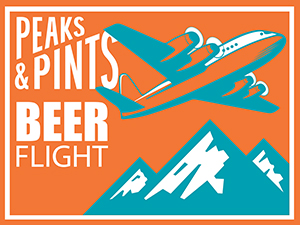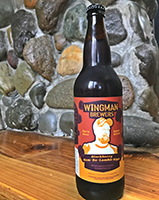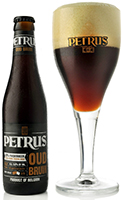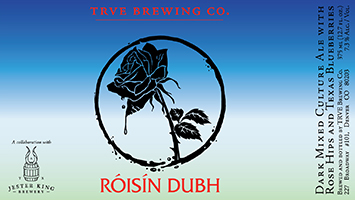 Sours get their trademark tartness and sourness from bacteria and wild yeasts — Lactobacillus, Acetobacter, Brettanomyces and other critters — which you wouldn’t find in other styles of beer. Each type of bacteria gives its own trademark flavor and aroma: Lactobacillus has a yogurt tang, Acetobacter has the sourness of vinegar, and Brettanomyces has a barnyard, earthy, or farmhouse aroma. For some of the sour styles, the wild bacteria and yeast come into the beer during an open or spontaneous fermentation, with open vats of wort exposed to the natural air. Other sour styles don’t use open fermentation, but they do rely on the bacteria and yeast in barrels to do a similar job. As the barrels get older, the more sour the beer gets, which leads to the common practice of blending beer from several different barrels, young and old, to get a consistent beer. Peaks and Pints offers a flight of five sour beers today in what we call Craft Beer Crosscut 9.16.18: A Flight of Sour Beer.
Sours get their trademark tartness and sourness from bacteria and wild yeasts — Lactobacillus, Acetobacter, Brettanomyces and other critters — which you wouldn’t find in other styles of beer. Each type of bacteria gives its own trademark flavor and aroma: Lactobacillus has a yogurt tang, Acetobacter has the sourness of vinegar, and Brettanomyces has a barnyard, earthy, or farmhouse aroma. For some of the sour styles, the wild bacteria and yeast come into the beer during an open or spontaneous fermentation, with open vats of wort exposed to the natural air. Other sour styles don’t use open fermentation, but they do rely on the bacteria and yeast in barrels to do a similar job. As the barrels get older, the more sour the beer gets, which leads to the common practice of blending beer from several different barrels, young and old, to get a consistent beer. Peaks and Pints offers a flight of five sour beers today in what we call Craft Beer Crosscut 9.16.18: A Flight of Sour Beer.
 Wingman Blackberry Sham-Ba-Lambic
Wingman Blackberry Sham-Ba-Lambic
6% ABV
Indigenous to the Senne Valley of Belgium, lambics stem from a farmhouse brewing tradition several hundred years old. These brews are spontaneously fermented — meaning pots containing the wort are left outside and uncovered, allowing whatever critters happen to be flying by on a passing breeze to ferment the beer. These wild yeast give lambics their distinct tartness. Most Belgian brewers also utilize aged hops, which add antibacterial properties to the beer, rather than bitterness or flavor. In the case of fruit lambics, whole fruits are traditionally added after halfway through fermentation to add sweetness and new dimensions of flavor as Wingman Brewers did with their Blackberry Sham-Ba-Lambic. This is the first beer the Tacoma brewery poured into its koelschip (pronounced “coolship”), which is a hollowed Lebanese cedar log where the lambic was cooled while Tacoma wild yeast and bacteria inoculated it. Next, it was aged two years in oak. Last, all the Pacific Northwest blackberries.
 Petrus Oud Bruin
Petrus Oud Bruin
5.5% ABV, 17 IBU
Oud bruins are similar to Flanders red ales, but tend to be a bit less tart, with additional darker fruit flavors such as figs, raisins or prunes. The malt is darker than the Flanders red ale and should taste of caramel, toffee, or chocolate. Like the red ale, Flanders brown ales are sour, but should not be acetic or vinegary. Enter Petrus Oud Bruin, an ale crafted in the Flemish tradition by Belgian brewery Bavic de Brabandere. The impact of barrel aging is apparent to the nose. Woodsy and vinegary scents dominate with mild traces of vanilla. Petrus Oud Bruin’s flavor is simple and not jarring, particularly appealing to those making a first sojourn in this style: There’s a rush of syrupy cherry sweetness, followed quickly by soft acidic sourness and woody oak notes like those in red wine. Oud Bruin finishes remarkably dry, with a tart quality that lasts well into the aftertaste. As far as sour ales go, this one is fairly mild.
 Almanac Summer In The City
Almanac Summer In The City
6.6% ABV, 23 IBU
Founders and former home-brewers Jesse Friedman and Damian Fagan started Almanac Beer Co. in 2010, crafting unique seasonal beers that use local Northern California produce, partnering with a different small farm each year to supply their fruit. Their Summer In the City dry-hopped farmhouse ale is aged in wine barrels with citrus, vanilla beans and spices for a juicy, citrus twang with faint balancing hints of vanilla. Spices are delicate, hard to place, more or less just add a nice balancing zest.
 Rodenbach Grand Cru
Rodenbach Grand Cru
6% ABV, 35 IBU
Flanders red ale is a style of sour ale brewed in West Flanders, Belgium. Flanders red ale is aged in oak barrels with Lactobacillus and Brettanomyces that add yogurt tang and barnyard notes and Acetobacter, which is the bacteria that creates vinegar. Consequently, Flanders red ales have sharp acidic, vinegar notes. Coming out of west Flanders is the World Beer Cup gold medal-winning Rodenbach Grand Cru, a blend of “young” beer (33%) and an older beer (67%) that has matured in oak vats. It is the high percentage of the older ripened-in-oak beer that gives it the complex and intense bouquet with a very long aftertaste like a Grand Cru wine. The late Michael Jackson bestowed upon this beer the titles of “World Classic” and “the Burgundy of Belgium.”
 TRVE Roisin Dubh
TRVE Roisin Dubh
7.3% ABV
TRVE Brewing opened in June 2012 in a long, skinny space on Denver’s major transportation corridor, Broadway. The layout gives the place a dark and divey feel, which is just fine with owner Nick Nunns, who names all of his beers after black heavy metal bands or songs and plays black metal music most of the time. “Roisin Dubh” is an old Celtic legend about Druids who wore red and black cloaks emblazoned with a rose, which that became a song in the 16th century, one of Ireland’s most famous political songs. TRVE’s version is a dark mixed culture brewed with rose hips then aged in whiskey barrels with Texas blueberries, thanks to collaborators Jester King Brewery out of Austin, Texas. The whiskey adds woody caramel to the tart blueberry flavor in both the aroma and flavor.
